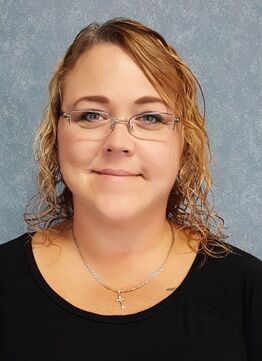 Adrienne Abercrombie Adrienne Abercrombie Blog post contributed by Adrienne Abercrombie, Deaf Advocate / Case Manager, Deaf and Hard of Hearing Services / Easterseals of Northeast Central Florida “CODA” stands for Child of Deaf Adults, which means that you are a hearing child with deaf parents. There are not a lot of people in this world that knows what a CODA is, unfortunately. When you elaborate on what it means, all of a sudden, they become so interested in your life as if you were some celebrity rock star, asking you so many questions that just does not make sense. “I didn’t know deaf people can have children…” “Can deaf people drive?” I really did not feel like a rock star. I felt more alone in this world than anything. No one truly understood what it was like to be me, a CODA. I did not talk. I did not want to use my voice to speak. I spoke with my hands and I truly believed I was your normal, average kid. I did not realize that I was different from everyone else. I thought I was deaf. Thanks to both of my parents, I had less than a handful of friends who understood exactly what it was like to be me. Thank God, they were CODAs too. I felt so close to them, more than I did with anyone else. I felt like they were my siblings. We had so much fun together and I did not have to pretend to be like everyone else. I was always me. My words were coming out all wrong. I struggled with my grammar. I knew only what I was able to hear. My mom ended up putting me in speech classes, with the schools advice, in order to learn how to pronunciate my words better. They told my parents that they were holding me back in kindergarten due to my speaking skills. My parents were so disappointed as if they had done something wrong. However, they did nothing wrong at all. It was then that they had decided that moving closer to my grandmother was the best thing to do in order for me to succeed. My grandmother was an intelligent woman and very soft spoken. It was easy to learn how to speak with her help. I had become attached to her. She understood me. She was my second mom. I will never forget this one day, my mom and I were walking through the grocery store, chatting with our hands. There were two girls, around my age, walking in the same aisle. They were following behind us with their hands over their mouths, whispering. I immediately knew they were making fun of us. I could feel it deep down in my gut. They started flapping their arms around imitating sign and giggling. This was not funny at all. In fact, this hurt my feelings. I tried to ignore them but, as they got a little bit closer, I could actually hear the words they were saying about us. All I wanted to do was shut down and cry. Deaf people do not enjoy being made fun of. Really, who does? I turned around and said, “Excuse me?” and, to my surprise, they both ran off, shocked, that I had heard everything. I felt so incredibly powerful in that moment while my mom, on the other hand, had no clue what had just happened. “Is your mom is Deaf and Dumb?” or “Is she a Deaf Mute?” I hear these two mostly used phrases all the time when it comes to explaining my life. Deaf and Dumb? Deaf Mute? Who came up with these titles? Just because you cannot hear, does not mean you are dumb or have no voice. Deaf people are just like hearing people except their ears are broken. That is all. This killed me on the inside. I was skeptical telling people that both my parents were deaf. I did not want to have to deal with all the crazy questions that came along with it. It never dawned on me that having deaf parents was actually something special. As time went on, I realized that it was actually GREAT having deaf parents! I could talk to my parents and CODA friends through windows. I could talk to them in complete privacy and no one knew what I was saying. I could even sneak out of the house, falling down outside of the bedroom window and knocking things over in the process, without being heard. (Sorry Mom!) I could even to jam out to my favorite music, singing out loud, as loud as I wanted, in whatever voice I wanted. I never got into any trouble. My dad would only tell me to be quiet when he said he could feel the vibrations, but in my mind, I was a rock star! I felt like I had no barriers. I was completely unstoppable! When I look back at my life, I realize that being different has taught me to have more compassion for those with disabilities. I understand wholeheartedly what it is like to be deaf because I thought I was deaf. Being raised in both the hearing world and the deaf world has shaped and formed me to be the proud CODA that I am today. I subtly mingle with the deaf world and they believe I am deaf because I act as if I am deaf. I am no longer afraid to answer the crazy questions that the hearing world asks nor am I afraid to educate people. I want everyone to understand that being deaf does not mean anything except their ears are broken. They do not need to be judged or looked down upon. They deserve every opportunity that a hearing person has in this world to succeed. My advice to the hearing world - go ahead and learn sign language now while you still can. It really is not a waste of your time. Whether you do it now or later, face it, your hearing will eventually fade. If you already know how to speak in sign language, you will not feel so lost when you do become deaf. Think about it, really, why wouldn’t you want to know sign? It's empowering. ABOUT THE AUTHOR: CODA Woman - Child of Deaf Adults Adrienne Abercrombie is the Deaf Advocate/Case Manager at Easterseals Northeast Central Florida which is located in Daytona Beach. She is a freelance and contracted ASL Interpreter since 1997 – 22+ years of experience as a Qualified Sign Language Interpreter, and has also worked at Sorenson Communications for 5+ years. She is always involved in the deaf community, enjoys attending deaf events and is always there to give a helping hand whenever it is needed. Her mother, Amy Barber, was the Deaf Advocate/Case Manager for 10+ years at Easterseals before she retired and Adrienne came in and took over the position to ensure the deaf community could continue to get the help that they need and deserve. Her father, John Hogg, was a Sign Language Professor at University of South Florida/Polk Community College in Lakeland, FL and her stepfather, Chuck Barber, was a Sign Language Professor at Daytona State College in Daytona Beach. Her grandmother, Pat Lozell, was strongly involved in the deaf community after retiring as a model in New York and believed in advocating for deaf rights. Pat did everything she could to help the deaf. She worked for the St. Augustine School for the Deaf and Blind which is located in St Augustine, FL. She also worked for Deaf and Hard of Hearing Services in Daytona Beach along with the FTRI department distributing specialized telephones to the deaf and hard of hearing. Deafness is hereditary on one side of her family but not on the other. She has a lot of family members (aunts, uncles and cousins) whom are deaf from birth. She also has some family members who have become deaf over time. Everyone in her family are big advocates for the deaf and they are constantly trying to ensure that they are treated fairly in every perspective of their lives. “Equality is the key to living a happy life,” Adrienne says. 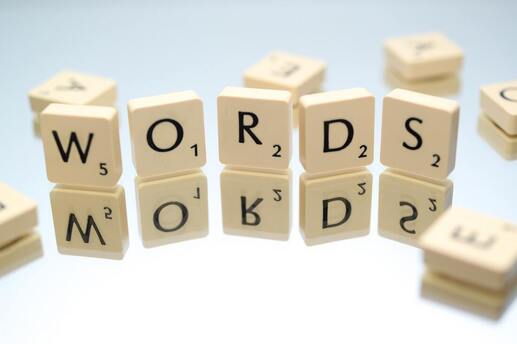 Words matter! Words matter! There are many things that shape how people talk about others with disabilities. It may be that they lack knowledge, have a fear of the unknown, don’t have experience or a personal point of reference with the disability or have received incorrect or distorted information about it. Any of us who speak (or write) about people with disabilities are important messengers. Beyond physical descriptions and therapeutic solutions, disabilities aren’t about limitations and restrictions. In fact, they are about abilities and opportunities. That is, if we communicate the stories correctly. Are you good at talking about disability accurately? When we take time to be mindful of our language and commit to expressing people’s stories with understanding and awareness, we play a vital part in changing the narrative about disabilities. Here are some things Easterseals wants you to know about disabilities language. Get these right and you’ll be part of the true movement toward understanding the limitless possibilities of people, no matter any label the world has attached to them.
See the person, not the ability, and there’s a great chance you’ll say or write it right every time; you’ll be able to tell stories with a contagious awareness that will enlighten and educate others. Words matter! 1/24/2019 From the bookshelf: Titles that teach children about inclusion, disabilities and friendshipRead Now 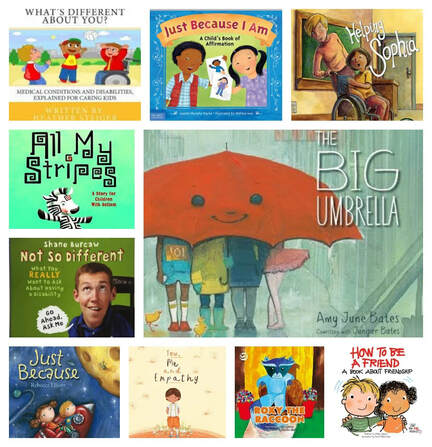 Books can challenge perspectives. They introduce new ideas and clear up misconceptions. For adults and children alike, books open our worlds to new ways of thinking. Parents and teaches know all too well that teaching children inclusion, tolerance, how to love themselves and be a good friend to others is an important job. The good news is that many authors do too. Have you ever considered helping a child understand himself or see herself differently? Do the words come easily to you or are they difficult to find? Books can be such a gift in helping us find the right words to explain difficult concepts. Below are a few we found that may help you tell the story your child needs to hear, for his benefit as well as others’. Helping Sophia Sophia is a third grader who uses a wheelchair, and on a day when her usual helper isn’t in school, Sophia’s classmates step up to the plate to support her. The story informs enlightens children about children with disabilities while teaching caring and kindness. You, Me and Empathy Quinn is here to model the meaning of empathy in this charming story about understanding, compassion and kindness towards others. The book includes discussion questions and activities to promote this learned behavior in young readers. The Big Umbrella The School Library Journal describes The Big Umbrella as a “sweet extended metaphor uses an umbrella to demonstrate how kindness and inclusion work... A lovely addition to any library collection, for classroom use or for sharing at home.” The Big Umbrella is all about inclusivity and leaves opportunities for easy discussion when the story ends too. How to Be a Friend: A Book about Friendship Does your child know how to make friends? Teaching children the traits of being a good friend is the work of parents and teachers, but it’s not a skill readily taught in schools. The book’s author introduces children to the qualities that build good friendships, including loyalty, trust and honesty. Just Because In Just Because, Clemmie’s little brother expresses his love for his big sister, whom he adores though she can’t do many of the things most children can. He loves her no matter what and accepters her as he is. This charming read celebrates sibling friendship while lovingly unfolding Clemmie’s disabilities. Roxy the Raccoon: A Story to Help Children Learn about Disability and Inclusion Roxy has friends who love to do everything together, but sometimes that means making changes to plans and accommodating each other’s needs. This story from the forest teaches how to include friends with disabilities and why friends are happy to do so. Just Because I Am: A Child's Book of Affirmation No matter their abilities, all children deserve to value themselves and recognize their worth simply because they exist! This sweet book, full of affirmations, helps children understand their value, which doesn’t lie in what they do or what they look like. The read includes a discussion and activities section for parents, teachers and caregivers too. Not So Different: What You Really Want to Ask About Having a Disability He’s often asked what it’s like living with a disability, so Shane Burcaw answers them with humor and refreshing honesty in this fun book. More than any explanation of his abilities, he’s most effective in explaining how, in more ways than not, he’s just like everyone else. What's Different about You? This book offers a comprehensive look explaining medical conditions, impairments and disabilities in a kid-friendly and developmentally appropriate manner. It helps children understand such differences for more successful interactions at school, in public or even at home. (What’s Different About You? is touted as helpful in explaining topics to siblings of a child with a disability). All My Stripes: A Story for Children with Autism This Gold Medal/Mom’s Choice award-winning book shares the story of Zane, a zebra with autism who’s worried his differences will negatively impact his relationships with other students. As the book unfolds, Zane and his readers learn that autism is only one of the many qualities that make him unique, special and worth befriending. *** Congratulations on seeking new ways to teach your child how to interact with others in the most loving and kind ways! We invite you to research the above titles to determine reading level and whether the content meets your child’s specific needs. Together, we can help children understand how much they have in common and how their differences are worth treasuring too. 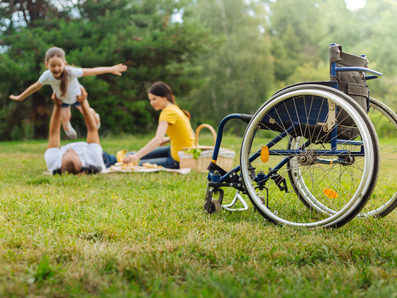 Everybody's fighting some kind of stereotype, and people with disabilities are no exception. The difference is that barriers people with disabilities face begin with people's attitudes — attitudes often rooted in misinformation and misunderstandings about what it's like to live with a disability. Myth 1: All persons who use wheelchairs are chronically ill or sickly. Fact: The association between wheelchair use and illness may have evolved through hospitals using wheelchairs to transport sick people. A person may use a wheelchair for a variety of reasons, none of which may have anything to do with lingering illness. Myth 2: Wheelchair use is confining; people who use wheelchairs are "wheelchair-bound." Fact: A wheelchair, like a bicycle or an automobile, is a personal assistive device that enables someone to get around. Myth 3: All persons with hearing disabilities can read lips. Fact: Lip-reading skills vary among people who use them and are never entirely reliable. Myth 4: People who are blind acquire a "sixth sense." Fact: Although most people who are blind develop their remaining senses more fully, they do not have a "sixth sense." Myth 5: People with disabilities are more comfortable with "their own kind." Fact: In the past, grouping people with disabilities in separate schools and institutions reinforced this misconception. Today, many people with disabilities take advantage of new opportunities to join mainstream society. Myth 6: Non-disabled people are obligated to "take care of" people with disabilities. Fact: Anyone may offer assistance, but most people with disabilities prefer to be responsible for themselves. Myth 7: Curious children should never ask people about their disabilities. Fact: Many children have a natural, uninhibited curiosity and may ask questions that some adults consider embarrassing. But scolding curious children may make them think having a disability is "wrong" or "bad." Most people with disabilities won't mind answering a child's question. Myth 8: The lives of people with disabilities are totally different than the lives of people without disabilities. Fact: People with disabilities go to school, get married, work, have families, do laundry, grocery shop, laugh, cry, pay taxes, get angry, have prejudices, vote, plan and dream like everyone else. Myth 9: It is all right for people without disabilities to park in accessible parking spaces, if only for a few minutes. Fact: Because accessible parking spaces are designed and situated to meet the needs of people who have disabilities, these spaces should only be used by people who need them. Myth 10: People with disabilities always need help. Fact: Many people with disabilities are independent and capable of giving help. If you would like to help someone with a disability, ask if he or she needs it before you act. Myth 11: There is nothing one person can do to help eliminate the barriers confronting people with disabilities. Fact: Everyone can contribute to change. You can help remove barriers by:
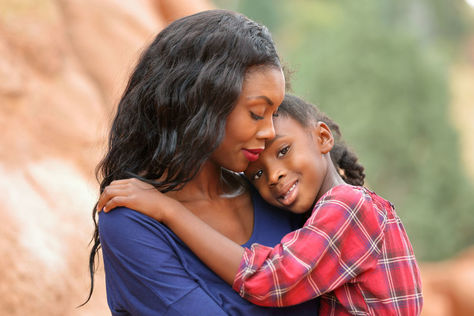 Fueled by the mission of taking on disability together, Easterseals organizations around the world bring awareness, treatment and advocacy to adults and children with disabilities in America. The United States Government recognizes National Child Health Day every October 1 and stated in its 2018 Presidential Proclamation that “On Child Health Day, we renew our commitment to ensuring the health and well-being of our young people, who are the future of our great country. All children deserve to grow up in loving homes with parents or guardians who are dedicated to empowering them to live healthy, safe, and successful lives.” Easterseals is a partner in making this vision a reality and achieves it by creating and managing programs and services that make profound, positive differences in people’s lives every day. Easterseals of Northeast Central Florida’s services can be organized by how they fit into the “Live, Learn, Work, Play, Act” model: LIVE: These programs offer hands-on, comprehensive, vital services and support to help people reach their full potential—regardless of challenges, needs or disabilities. They include Agency for Persons with Disabilities - APD Application assistance, Autism Early Diagnostic and Functional Assessment Clinic, Feeding Aversion Clinic, Early Steps evaluation and treatment, an equipment loan program, Florida Telecommunications Relay, Inc., interpreter services, pediatric audiology, social skills training and more. LEARN: These programs are designed to help children and adults learn—and often re-learn— basic functions, master skills needed to develop and thrive, and be sharp and active as they age. They include American Sign Language® classes, case management/service coordination, Child Development Centers, Easterseals Charter School, Pre-Kindergarten, Evelyn Lynn Child Development Center at Project WARM, school-based therapy, Voluntary Pre-Kindergarten and more. WORK: These programs include a range of training, placement and related services that help people prepare for the workforce—because meaningful work is often the key to overcoming challenges and having a good life. Examples of Easterseals’ offerings include clinical training, Deaf advocacy, internships and physician in-services. PLAY: Easterseals is committed to offering fun, healthy programs for children, adults and caregivers to relax, connect with friends and engage in constructive activities—all necessary to living the best life possible. These programs and activities include accessible playgrounds, Camp Challenge, Joey’s Gift Respite Care, social skills training, and Tiny Toes Play Group for Early Steps. ACT: Easterseals is fortunate to have a vibrant community of friends and supporters who stand with those who face challenges by volunteering, advocating, donating and participating in events that inspire us all and sustain our cause. We encourage all citizens to get involved with Easterseals as an advocate, joining a board or committee, engaging in community collaboration, joining the Disability Coalition, contributing to the equipment loan closet, giving or donating funds, participating in special events and volunteering. To learn more about how to engage with Easterseals and learn more about its programs, connect by calling 386-255-4568, 1-877-255-4568 (toll-free) or 386-310-1157 (videophone); emailing [email protected]; or visiting us online at www.eastersealsnecfl.org. 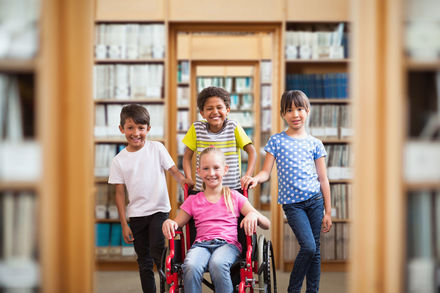 In our neck of the woods, the 2018-19 school year is about to be at full throttle. Parents have sharpened the No. 2 pencils, stocked backpacks, purchased polo shirts and planned lunches. But, are these children ready to reconnect with their schoolmates with disabilities in ways that makes them feel comfortable with their questions and compassionate in their actions? Easterseals of Northeast Central Florida encourages parents to discuss with their children how to think about and connect with people with disabilities. What can parents teach their children about disabilities? What should they say? Here are four suggestions on what to keep in mind when you talk to your child about their peers (and others) with disabilities: 1. Words are important. Teach your child the appropriate words to use when talking about the differences they may see in others, such as “disability,” “special needs,” or even the name of a specific disability like Down Syndrome or Autism. Teach your child that name calling is not acceptable, and neither are jokes at a person’s expense. Always encourage your child to use respectful language - or “people first” language - when talking about a person with disabilities. Ex, a friend with autism versus an autistic friend; a child who uses a wheelchair versus a wheelchair bound child. 2. A person with a disability is not necessarily sick. Educate you child that they cannot “catch” a disability from someone else. Though an illness can cause a disability, reassure your child that the disability is not a sickness. 3. Your child has things in common with others who have disabilities. Everyone has differences, it’s just that some differences are more noticeable. Instead, focus on what your child and others have in common: eyes, hands, smiles, feelings, etc. And, though someone may have a physical disability does not mean they have a cognitive one. Adults and kids with disabilities can do many things people without those challenges can do, it just may take them a little bit longer or they may accomplish the task in a different way. 4. Questions are allowed and welcomed! Children are naturally curious, and it’s one of the things we love about kids! Encourage your child to ask you questions, and if you don’t know the answer, Easterseals is always here to help. (Call us at 386-255-4568.) Or, pass your child’s question along to a teacher or the child’s parent. Most parents would invite an opportunity to bridge the gap between their child and yours. Your child is looking to you to guide them on how to interact with others, including those with disabilities. Be a strong example by showing respect and kindness. When you do, you join Easterseals in changing the way the world defines and views disability – whether physical, intellectual, emotional or social – by making profound, positive differences in people's lives everyday. Sources: Easterseals, today.com, scarymommy.com, care.com |
Details
Archives
May 2024
Categories
All
|

 RSS Feed
RSS Feed